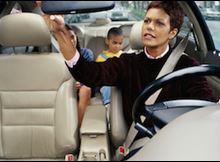Avoid distracted driving to keep your family safe on the road
We want our families to be safe so we teach our kids to look before they cross the street, wear a helmet when they ride a bicycle, and buckle their seatbelt when riding in the car. But what if there were something that you as a parent were doing every day that put your family in danger? Distracted driving may be one of those things, and it contributes to tens of thousands of deaths each year in our country.
What is distracted driving?
Distracted driving occurs when your attention is diverted while driving, causing you to take your eyes off the road or your hands off the wheel or makes you think about anything other than driving. These distractions include texting, eating, adjusting radio or other car controls, handling a navigation system, interacting with other passengers, grooming, and even watching other occurrences on the road, such as an accident. Texting is the most dangerous of these distractions because it changes your visual, manual, and cognitive focus on the road and those around you. Anything that limits your focus on the road also limits your ability to safely respond to a collision. It only takes a second of your attention to change a life forever.
Why are we concerned about distracted driving?
 In 2017 more than 40,000 people died in the U.S. on our roadways, many of these related to distracted driving. In Florida, there were 49,288 crashes related to distracted driving in 2017. This number has increased from the 44,947 crashes in 2015. Of these crashes in 2017, 3,012 individuals involved in the incident suffered incapacitating injuries, and 214 resulted in fatal injury.
In 2017 more than 40,000 people died in the U.S. on our roadways, many of these related to distracted driving. In Florida, there were 49,288 crashes related to distracted driving in 2017. This number has increased from the 44,947 crashes in 2015. Of these crashes in 2017, 3,012 individuals involved in the incident suffered incapacitating injuries, and 214 resulted in fatal injury.
The highest rate of distraction-related crashes with fatalities is among drivers under the age of 20, and teens 15 to 19 years old are at highest risk for distracted driving incidents. Did you know that teens are six times more likely to be in a car accident from texting and driving than an accident due to driving drunk? Teens that text and drive have a 400% higher risk than adults to be involved in a motor vehicle collision. 41% of teens state that they have witnessed their parents distractedly driving while using their smartphones.
Knowing these statistics, it is apparent that distracted driving should be of concern for you, your family, and our community. The rise of the digital age has also increased this concern: 82.7% of people in the U.S. are smartphone users, which is an increase from 67.6% in 2014.
How can you and your teen become a safer driver?
It is of utmost importance to set an example for children and teenagers who may be learning to drive or already driving. The following are tips to avoid visual, manual, and cognitive distractions:
- Turn off your cell phone, and place in a glove compartment, purse, or backpack.
- Address messages or make calls before driving. If you are expecting a long drive, make stops on the way to address these again.
- Avoid multitasking, such as adjusting radio or climate controls and managing the navigation system. Prepare your settings and route before you start driving to limit the need to adjust these while on the road.
- Dress and groom prior to getting into your vehicle.
- Eat meals and snacks before or after your trip.
- Make sure younger passengers are ready before leaving, such as ensuring that seat belts are buckled, snacks are provided, and entertainment is available.
- Avoid blasting music as this can distract you from being aware of your surroundings.
- If you are a passenger, you can help answer phone calls or text messages, adjust climate controls and radio volume, pay attention to road signs, and attend to other passengers in the vehicle.
If you have a teenager who drives, the following are tips you can use to address distracted driving:
 Talk to your teen about the above tips, and make it ongoing conversation. 62% of teens said that frequent conversations with their parents are effective.
Talk to your teen about the above tips, and make it ongoing conversation. 62% of teens said that frequent conversations with their parents are effective. - Set an example as the adult. This alone can change your teen’s behavior.
- Teach them to silence their phones while driving. Consider various programmable features on a smartphone that can disable certain phone functions while using the GPS. Other features include disabling texting, automated text response, and holding calls while driving.
- If you are driving with them as a passenger, prompt them to delegate tasks to you and minimize conversation to reduce further distraction.
- Sign a pledge with your teen. Develop an agreement that both of you can support against distracted driving. A pledge or an agreement can help guide your conversation.
Where can you find more information?
There are various resources for drivers to identify ways to avoid distracted driving. These resources also include how you can talk to your teens about types of distractions, parent-teen driving agreements, and tips on how to address various driving risks. Visit the Centers for Disease Control and Prevention (CDC), The Florida Department of Highway Safety and Motor Vehicles, and The National Safety Council.









